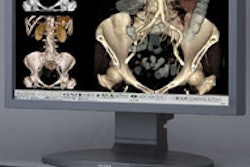VIENNA - Radiologists need to be proactive about setting the agenda for outsourcing diagnostic imaging reads to remote locations, or they may soon find that other interested parties will define the agenda for them, according to a trio of presentations at the European Congress of Radiology (ECR) on Monday.
"We are doing this in the interests of our patients as part of our duty of care," said Dr. Lawrence Lau, a radiologist at Vaucluse Hospital in Melbourne, Australia. "If we do nothing about it ourselves, then we are not acting in the best interests of our patients."
Lau spoke about work on the development of international consensus standards for clinical teleradiology through the International Radiology Quality Network (IRQN), a group of national and international radiology organizations. He recognized that devising standards of practice for teleradiology in both developed and developing nations will be a significant challenge.
Dr. Bruno Silberman, a radiologist at the Centre d'Imagerie Medicale in Paris and chairman of the European Association of Radiology (EAR) professional organization committee, noted there are many potential pitfalls to remote outsourced diagnostic imaging interpretation, particularly if teleradiology becomes a general method of service delivery.
"This is not a theoretical discussion any longer," he said. "Radiologists should be aware that if they don't start thinking about the best use of clinical teleradiology now, they will discover that they will not even be asked about how to organize such a service."
The speakers acknowledged that teleradiology has definite benefits, and under the correct guidelines, can improve the quality of patient care. For communities that lie outside major urban areas and where there is insufficient work to attract a full-time radiologist, teleradiology permits images to be taken locally and interpreted remotely.
In addition, images of complex problems outside a group's area of expertise can be transmitted to a specialist for interpretation, consultation, or a second opinion. This permits a patient to be managed and treated locally, which is beneficial economically and socially.
Lastly remote image reading capabilities can provide 24/7 radiology coverage when a local area does not have enough radiologists to provide 24-hour, 7-day-a-week, 365-day-a-year services.
According to Dr. James Borgstede, chairman of the American College of Radiology Board of Chancellors, outsourced diagnostic imaging:
- Must not reduce quality patient care.
- Has to be consistent with the ACR Technical Standard for Teleradiology.
- Must require practitioners to have the appropriate licensure and medical liability insurance for the geographic area in which they are performing services.
- Must require practitioners to have the appropriate credentialing and licensure for each facility in which they perform services.
- Must not lead to the ghosting of reports.
"Ghosting was defined as having someone else do the work for you, and then sign a report in such a manner that would lead one to believe that the signing physician was the primary or sole interpreter of that examination," Borgstede said.
He reported that the ACR Ethics Committee recently issued a statement on the subject which states that: "It is unethical for a radiologist who has not personally interpreted the images obtained in a radiologic examination to sign a report of that examination in a manner that causes the reader of that report to believe that the signing radiologist is in the primary or sole interpreter of that examination."
Silberman said the EAR recommends that teleradiology guidelines include advice on the appropriate occasions to use the service; minimum standards for the equipment to be used for imaging, data transmission, and remote interpretation; and strict definitions of who can issue the final report.
The EAR guidelines hold that remote image interpretation services should not be used if it results in local radiology services being cut.
"The agreement and full acquiescence of local radiologists should be obtained in order for the development of teleradiology services to be implemented," Silberman said.
Accreditation and quality of service are also key points within the EAR guidelines, according to Silberman.
"The radiologists providing the service must be properly accredited and registered with the European community," he said. "They should be formally registered in the country in which the teleradiology services are being provided, and should be registered and subject to quality and revalidation requirements of the EU member state for which they wish to provide teleradiology services."
Teleradiology should also not be used to generate additional work from residents, nor should its practice compromise a physician's radiological training.
"Under no circumstances should teleradiology reports be made by radiologists in training, and the implementation of teleradiology should not be to the detriment of the training in the originating center," Silberman said of the EAR guidelines.
Silberman acknowledged that without a threat of sanctions, the EAR guidelines could be ignored. However, the existence of documentation on best practices for image outsourcing should give organized radiology a position from which to lobby for legislation.
"Not infrequently, standards are developed in isolation by individual organizations, and they may not take into account what their neighbor is doing," Lau said. "This is slowly changing. Now parties are keen to do this together, and have seen that there is a need to do this together."
By Jonathan S. Batchelor
AuntMinnie.com staff writer
March 8, 2005
Related Reading
ACR international teleradiology task force releases white paper, February 15, 2005
Legislation looms over offshore teleradiology services, May 27, 2004
ACR bolsters teleradiology statement, May 14, 2004
Teleradiology providers handle after-hours caseload effectively, May 3, 2004
Overseas teleradiology faces legal hurdles, February 21, 2003
Copyright © 2005 AuntMinnie.com



















